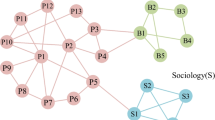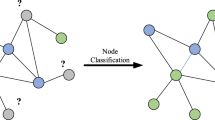Abstract
Network embedding aims to learn a low-dimensional representation vector for each node while preserving the inherent structural properties of the network, which could benefit various downstream mining tasks such as link prediction and node classification. Most existing works can be considered as generative models that approximate the underlying node connectivity distribution in the network, or as discriminate models that predict edge existence under a specific discriminative task. Although several recent works try to unify the two types of models with adversarial learning to improve the performance, they only consider the local pairwise connectivity between nodes. Higher-order structural information such as communities, which essentially reflects the global topology structure of the network, is largely ignored. To this end, we propose a novel framework called CANE to simultaneously learn the node representations and identify the network communities. The two tasks are integrated and mutually reinforce each other under a novel adversarial learning framework. Specifically, with the detected communities, CANE jointly minimizes the pairwise connectivity loss and the community assignment error to improve node representation learning. In turn, the learned node representations provide high-quality features to facilitate community detection. Experimental results on multiple real datasets demonstrate that CANE achieves substantial performance gains over state-of-the-art baselines in various applications including link prediction, node classification, recommendation, network visualization, and community detection.













Similar content being viewed by others
Notes
References
Adamic LA, Lukose RM, Puniyani AR, Huberman BA (2001) Search in power-law networks. Phys Rev E 64:046135
Airoldi EM, Blei DM, Fienberg SE, Xing EP (2008) Mixed membership stochastic blockmodels. J Mach Learn Res 9:1981–2014
Ban Y, Pu J, Chen Y, Wang Y (2018) Negan: network embedding based on generative adversarial networks. In: IJCNN, pp 1–8
Ball B, Newman EJ (2011) An efficient and principled method for detecting communities in networks. Phys Rev E 84:036103
Bhagat S, Cormode G, Muthukrishnan S (2011) Node classification in social networks. In: Social network data analytics, pp 115–148
Blei DM, Lafferty JD et al (2007) A correlated topic model of science. Ann Appl Stat 1:17–35
Blei DM, Ng AY, Jordan MI (2003) Latent dirichlet allocation. J Mach Learn Res 3:993–1022
Bojchevski A, Shchur O, Zügner D, Günnemann S (2018) Netgan: generating graphs via random walks. arXiv:1803.00816
Bosch A, Zisserman A, Muñoz X (2006) Scene classification via PLSA. In: ECCV, pp 517–530
Cai X, Han J, Yang L (2018) Generative adversarial network based heterogeneous bibliographic network representation for personalized citation recommendation. In: AAAI, pp 5747–5754
Cao S, Lu W, Xu Q (2015) Grarep: learning graph representations with global structural information. In: CIKM, pp 891–900
Cao S, Lu W, Xu Q (2016) Deep neural networks for learning graph representations. In: AAAI, pp 1145–1152
Cavallari S, Zheng VW, Cai H, Chang KCC, Cambria E (2017) Learning community embedding with community detection and node embedding on graphs. In: CIKM, pp 377–386
Cha Y, Cho J (2012) Social-network analysis using topic models. In: Proceedings of the 35th international ACM SIGIR conference on Research and development in information retrieval. ACM, pp 565–574
Chen Z, Li X, Bruna J (2017) Supervised community detection with line graph neural networks
Dai Q, Li Q, Tang J, Wang D (2018) Adversarial network embedding. In: AAAI, pp 1–9
Dai Q, Li Q, Zhang L, Wang D (2019) Ranking network embedding via adversarial learning. In: PAKDD, pp 27–39
Dai Q, Shen X, Zhang L, Li Q, Wang D (2019) Adversarial training methods for network embedding. In: WWW, pp 329–339
De Cao N, Kipf T (2018) Molgan: an implicit generative model for small molecular graphs. arXiv:1805.11973
De Meo P, Ferrara E, Fiumara G, Provetti A (2011) Generalized Louvain method for community detection in large networks. In: ISDA, pp 88–93
Dhillon IS, Guan Y, Kulis B (2004) Kernel k-means: spectral clustering and normalized cuts. In: SIGKDD, pp 551–556
Dong HW, Hsiao WY, Yang LC, Yang YH (2018) Musegan: multi-track sequential generative adversarial networks for symbolic music generation and accompaniment. In: AAAI, pp 34–41
Du B, Peng H, Wang S, Bhuiyan MZA, Wang L, Gong Q, Liu L, Li J (2019) Deep irregular convolutional residual LSTM for urban traffic passenger flows prediction. IEEE Trans Intell Transp Syst 21(3):972–985
Gao H, Pei J, Huang H (2019) Progan: network embedding via proximity generative adversarial network. In: SIGKDD, pp 1308–1316
Griffiths T (2002) Gibbs sampling in the generative model of latent Dirichlet allocation
Griffiths TL, Jordan MI, Tenenbaum JB, Blei DM (2004) Hierarchical topic models and the nested Chinese restaurant process. In: Advances in neural information processing systems, pp 17–24
Griffiths TL, Steyvers M (2004) Finding scientific topics. Proc Nat Acad Sci 101:5228–5235
Grover A, Leskovec J (2016) node2vec: scalable feature learning for networks. In: KDD, pp 855–864
Henderson K, Eliassi-Rad T (2009) Applying latent Dirichlet allocation to group discovery in large graphs. In: SAC, pp 1456–1461
Goodfellow I, Mirza M, Xu B, Warde-Farley D, Ozair S, Courville A, Bengio Y (2014) Generative adversarial networks. In: NeurIPS, pp 2672–2680
Jia Y, Zhang Q, Zhang W, Wang X (2019) Communitygan: community detection with generative adversarial nets. In: WWW, pp 784–794
Kanungo T, Mount DM, Netanyahu NS, Piatko CD, Silverman R, Wu AY (2002) An efficient k-means clustering algorithm: analysis and implementation. IEEE Trans Pattern Anal Mach Intell 24(7):881–892
Latouche P, Birmele E, Ambroise C (2012) Variational bayesian inference and complexity control for stochastic block models. Stat Modell 12:93–115
Li C, Wang S, Yang D, Li Z, Yang Y, Zhang X, Zhou J (2017) PPNE: property preserving network embedding. In: DASFAA, pp 163–179
Li J, Zhu J, Zhang B (2016) Discriminative deep random walk for network classification. In: ACL, pp 1004–1013
Liben-Nowell D, Kleinberg J (2007) The link-prediction problem for social networks. J Am Soc Inform Sci Technol 58:1019–1031
Long B, Xu X, Zhang Z, Philip SY (2007) Community learning by graph approximation. In: ICDM, pp 232–241
Ma T, Chen J, Xiao C (2018) Constrained generation of semantically valid graphs via regularizing variational autoencoders. In: NeurIPS, pp 7113–7124
Maaten L, Hinton G (2008) Visualizing data using T-SNE. J Mach Learn Res 9:2579–2605
Mimno D, Li W, McCallum A (2007) Mixtures of hierarchical topics with pachinko allocation. In: ICML, pp 633–640
Newman D, Asuncion A, Smyth P, Welling M (2009) Distributed algorithms for topic models. J Mach Learn Res 10:1801–1828
Newman ME (2004) Fast algorithm for detecting community structure in networks. Phys Rev E 69:066133
Newman ME (2006) Modularity and community structure in networks. Proc Nat Acad Sci 103:8577–8582
Ng AY, Jordan MI, Weiss Y (2002) On spectral clustering: analysis and an algorithm. In: Advances in neural information processing systems, pp 849–856
Palangi H, Deng L, Shen Y, Gao J, He X, Chen J, Song X, Ward R (2016) Deep sentence embedding using long short-term memory networks: analysis and application to information retrieval. IEEE/ACM Trans Audio Speech Lang Process 24:694–707
Perozzi B, Al-Rfou R, Skiena S (2014) Deepwalk: online learning of social representations. In: SIGKDD, pp 701–710
Radicchi F, Castellano C, Cecconi F, Loreto V, Parisi D (2004) Defining and identifying communities in networks. Proc Nat Acad Sci 101:2658–2663
Ribeiro LF, Saverese PH, Figueiredo DR (2017) struc2vec: learning node representations from structural identity. In: SIGKDD, pp 385–394
Sun FY, Qu M, Hoffmann J, Huang CW, Tang J (2019) vGraph: a generative model for joint community detection and node representation learning. arXiv:1906.07159
Sun Y, Wang S, Hsieh TY, Tang X, Honavar V (2019) Megan: a generative adversarial network for multi-view network embedding. IJCAI
Sutton RS, McAllester D, Singh S, Mansour Y (2000) Policy gradient methods for reinforcement learning with function approximation. In: NeurIPS, pp 1057–1063
Tang H, Shen L, Qi Y, Chen Y, Shu Y, Li J, Clausi DA (2013) A multiscale latent dirichlet allocation model for object-oriented clustering of VHR panchromatic satellite images. IEEE Trans Geosci Remote Sens 51:1680–1692
Tang J, Qu M, Wang M, Zhang M, Yan J, Mei Q (2015) Line: large-scale information network embedding. In: WWW, pp 1067–1077
Tang L, Liu H, Zhang J, Nazeri Z (2008) Community evolution in dynamic multi-mode networks. In: SIGKDD, pp 677–685
Tillé Y, Qualité L, Wilhelm M (2018) Sampling designs on finite populations with spreading control parameters. Stat Sin 28(1):471–504
Tu C, Zeng X, Wang H, Zhang Z, Liu Z, Sun M, Zhang B, Lin L (2018) A unified framework for community detection and network representation learning. IEEE Trans Knowl Data Eng 31(6):1051–1065
Van Laarhoven T (2018) Generative models for local network community detection. Phys Rev E 97:042316
Wang D, Cui P, Zhu W (2016) Structural deep network embedding. In: KDD, pp 1225–1234
Wang H, Wang J, Wang J, Zhao M, Zhang W, Zhang F, Xie X, Guo M (2018) Graphgan: graph representation learning with generative adversarial nets. In: AAAI, pp 1–9
Wang S, Hu X, Yu PS, Li Z (2014) Mmrate: inferring multi-aspect diffusion networks with multi-pattern cascades. In: SIGKDD, pp 1246–1255
Wang S, Tang J, Aggarwal C, Liu H (2016) Linked document embedding for classification. In: CIKM, pp 115–124
Wang S, Tang J, Morstatter F, Liu H (2016) Paired restricted Boltzmann machine for linked data. In: CIKM, pp 1753–1762
Wang X, Cui P, Wang J, Pei J, Zhu W, Yang S (2017) Community preserving network embedding. In: AAAI, pp 203–209
Wolfe J, Haghighi A, Klein D (2008) Fully distributed EM for very large datasets. In: ICML, pp 1184–1191
Xu L, Cao J, Wei X, Yu P (2019) Network embedding via coupled kernelized multi-dimensional array factorization. IEEE Trans Knowl Data Eng. https://doi.org/10.1109/TKDE.2019.2931833
Xu L, Wang J, He L, Cao J, Wei X, Yu P, Yamanishi K (2019) MixSp: a framework for embedding heterogeneous information networks with arbitrary number of node and edge types. IEEE Trans Knowl Data Eng. https://doi.org/10.1109/TKDE.2019.2955945
Xu L, Wei X, Cao J, Yu PS (2017) Embedding of embedding (EOE) joint embedding for coupled heterogeneous networks. In: Proceedings of the tenth ACM international conference on web search and data mining, pp 741–749
Yu W, Zheng C, Cheng W, Aggarwal CC, Song D, Zong B, Chen H, Wang W (2018) Learning deep network representations with adversarially regularized autoencoders. In: SIGKDD, pp 2663–2671
Yu X, Ren X, Sun Y, Gu Q (2014) Personalized entity recommendation: a heterogeneous information network approach. In: SIGKDD, pp 283–292
Zhang H, Qiu B, Giles CL, Foley HC, Yen J (2007) An LDA-based community structure discovery approach for large-scale social networks. In: Intelligence and security informatics, pp 200–207
Zhang Y, Chen M, Huang D, Wu D, Li Y (2017) idoctor: personalized and professionalized medical recommendations based on hybrid matrix factorization. Future Gen Comput Syst 66:30–35
Zhang Y, Lyu T, Zhang Y (2018) Cosine: community-preserving social network embedding from information diffusion cascades. In: AAAI, pp 1–9
Zheng W, Ge B, Wang C (2019) Building a TIN-LDA model for mining microblog users’ interest. IEEE Access 7:21795–21806
Acknowledgements
This work was supported by Guangdong Key Area R & D Plan (Grant No. 2020B010164002), HK RGC Collaborative Research Fund (RGC No. C5026-18G), and the Fundamental Research Funds for the Central Universities (No. NZ2020014).
Author information
Authors and Affiliations
Corresponding author
Additional information
Publisher's Note
Springer Nature remains neutral with regard to jurisdictional claims in published maps and institutional affiliations.
Rights and permissions
About this article
Cite this article
Wang, J., Cao, J., Li, W. et al. CANE: community-aware network embedding via adversarial training. Knowl Inf Syst 63, 411–438 (2021). https://doi.org/10.1007/s10115-020-01521-9
Received:
Revised:
Accepted:
Published:
Issue Date:
DOI: https://doi.org/10.1007/s10115-020-01521-9




